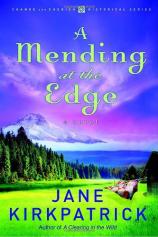A Mending at the Edge: Change and Cherish Historical Series #3
Review
A Mending at the Edge: Change and Cherish Historical Series #3
A MENDING AT THE EDGE satisfyingly concludes Jane Kirkpatrick’s Change and Cherish trilogy, based on the true-life story of Emma Wagner Giesy, a strong-willed woman who seeks to find her place in a restrictive Christian colony in Oregon during the mid-1800s.
If you haven’t read the first two installments, stop here and begin with book one, A CLEARING IN THE WILD. These novels are much richer as a series than they are as stand-alones.
In A CLEARING IN THE WILD, we’re introduced to Emma, a teenage girl in the Missouri Bethelites community who rebels against gender roles and longs for adventure. She wangles her way to accompany her husband, Christian Giesy, on a trip west to explore possible new locations for the colony --- historically, the only woman to help found a communal society in this time period, Kirkpatrick tells us.
The second novel in the series, A TENDERING IN THE STORM, is written from two points of view --- Louisa Keil’s and Emma’s. It finds the feisty Emma living in the Washington Territory with Christian and little ones Andy and Kate. Readers will enjoy seeing Emma’s gifts unfold and watching her grow as a woman of faith and as a mother who deeply cares for her children. Her mistakes, however, will cost her dearly.
A MENDING AT THE EDGE finds Emma and her four young kids back with the repressive Bethel colony, after escaping from her abusive second husband Jack. Although offering her shelter and work at the colony, its mercurial and autocratic leader, Wilhelm Keil, is clear that Emma must do what she can to reconcile with Jack.
Kirkpatrick weaves information about women and divorce during this time period into the storyline, and continues her exploration of gender roles as she has throughout the series. Divorce, we discover, while not impossible, would likely result in Emma’s dismissal from the colony. Divorced women of that time in Oregon also lost custody of their children, the author tells us.
However, as Emma labors in the colony and her work is credited towards the community for goods she wishes to acquire, Jack shows up and threatens to use his privileges as her husband to claim goods for himself that she has earned. And shockingly enough, the community does not protest, as he is her lawful husband. For the modern reader, Emma’s situation and those of other characters introduced later in the story provide a startling realization of how women’s rights were not protected in this era, and how little recourse females had if they were abused by their husbands. Kirkpatrick is a clinical social worker, as well as a novelist, which may explain her knowledgeable grasp of this plot thread.
Things smooth out a bit when Jack leaves, and Emma is free to press for the building of a home for herself and her family. However, to remain in the community, Emma finds that she must give up more than she ever dreamed. Will her sacrifice be worth the pain it will cause? Readers may find her decision shocking, but the author casts Emma’s actions in the context of her time period, which aids understanding.
Kirkpatrick paints an intriguing portrait of a woman who chafes at the conventional and longs to live an extraordinary life. Emma’s creativity is repeatedly stifled, but she finds ways to use conventional means (crafts, quilting) to express her gifts in unusual ways. Her impetuousness often has consequences, especially her unfortunate marriage to Jack, but she has matured since book one and learned patience and tact. These things help smooth her path as she finds a way to become a part of the colony yet remain true to herself. Emma also learns that even as she grieves the loss of family members she loves, she is able to reach out to others in need and help them heal.
I appreciated how Kirkpatrick helps the reader at every turn to understand the story, from the cast of characters at the beginning (an extensive number by book three) to the rich historical details, for which she includes a glossary of terms and German words used by the colony.
Readers fascinated with Emma’s story will find information in the author’s notes about the Western colony founded by German Americans as it is remembered today. Kirkpatrick notes that it is possible to visit the novel’s historical village of Aurora (population 600) and the Colony Museum today. She has also written a nonfiction book about the colony, its quilts, music, food and culture that will be published in the fall of 2008.
Fans of the Change and Cherish series will appreciate A MENDING AT THE EDGE and the forthcoming nonfiction title, which provide more windows into this fascinating and sometimes shockingly restrictive community and this time period of the Old West.
Reviewed by Cindy Crosby on November 13, 2011










